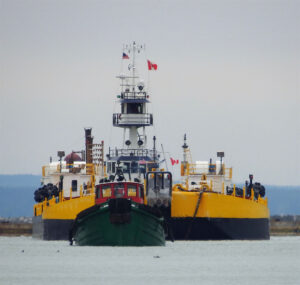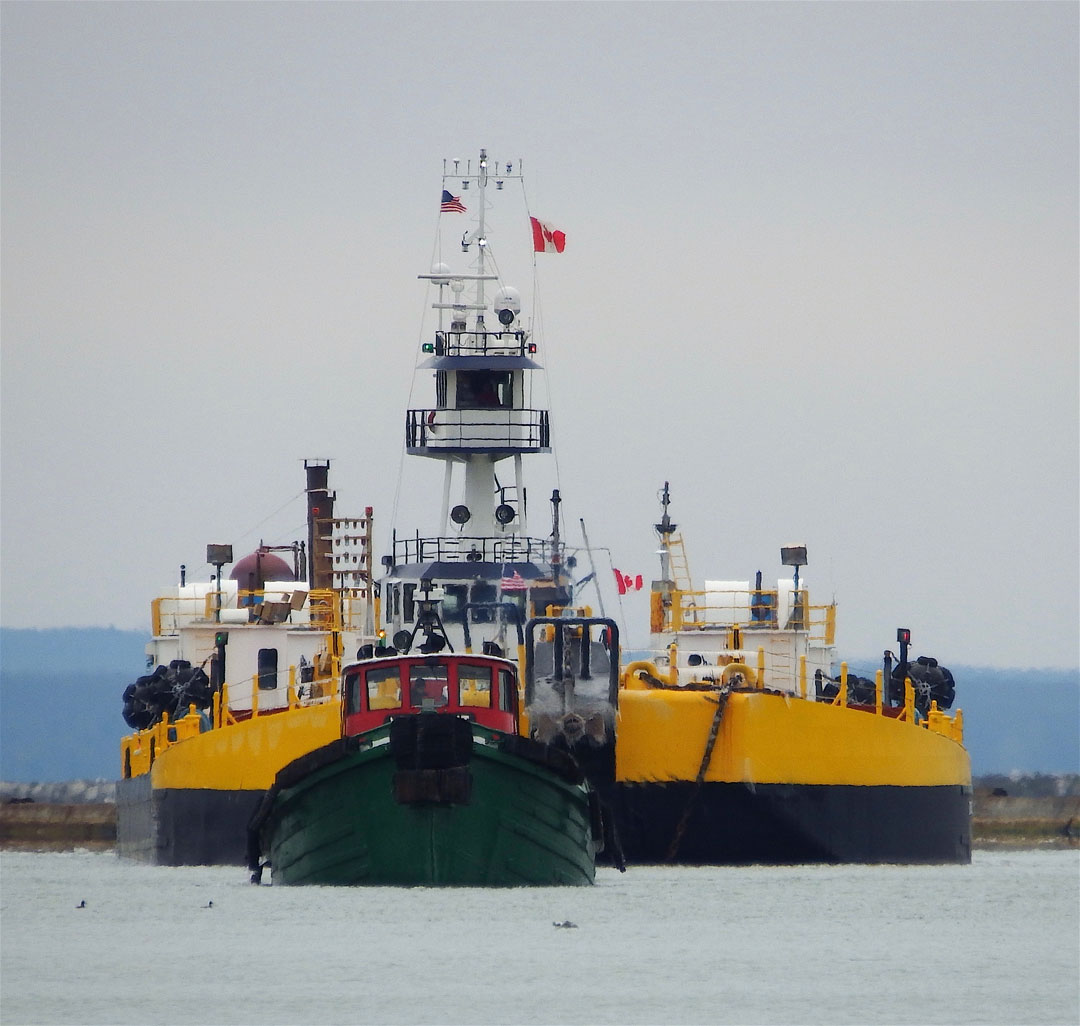
Air temperatures on a December day in Buffalo, N.Y., average about 20 degrees Fahrenheit or lower, with water temperatures around 40 and dropping, but the cargo on a newly arrived barge is maintained at 300 degrees. Snowflakes falling on the deck turn to steam.
Double Skin 509A, with a safety-yellow band painted on the bow, is pushed by the tugboat New York, which has a white superstructure, blue trim and a large blue “V” embedded neatly in a horizontal green stripe on the stacks. It’s a new livery on the Great Lakes and Vane Brothers’ initial tugboat/barge unit in the region. The destination on this wintry day was a set of asphalt storage tanks on the Niagara River just upstream from the South Grand Island Bridge in Tonawanda, N.Y., less than a dozen miles from Niagara Falls.
In the past two decades, Maryland-based Vane Brothers has expanded operations to other points on the East Coast, Gulf of Mexico, Caribbean and West Coast. This Vane unit arrived on the Great Lakes in the fall of 2020. “(The region) represents an exciting business opportunity in a new geographic area,” said Vane Brothers President C. Duff Hughes.
New York is a 4,200-horsepower Elizabeth Anne-class tug delivered by St. Johns Ship Building of Palatka, Fla., in 2018. Double Skin 509A was built at Conrad’s Deepwater South shipyard in Amelia, La., and delivered in 2015. The 50,000-barrel barge — 361 feet long with a 62-foot beam and 24.5-foot depth — is purpose-built to handle asphalt. Put another way, Double Skin 509A carries as much asphalt as 228 tank trailer trucks.
The Vane unit loads at Marathon Petroleum’s Detroit Refinery on the River Rouge, a narrow industrial waterway crisscrossed by six bridges. Two of the bridges must be transited twice because a turning basin needs to be used to position the vessels for loading and departure.
“On my first day up here, we spent an hour of my first 90 minutes on the boat waiting for two railroad bridges to open up so we could get to the barge,” said Vane Capt. Rusty Harris. It reminded him of Norfolk, Va., and Philadelphia, where he’s also worked. But he added, “The three train bridges and three road bridges on the River Rouge are narrower and not on a straight shot of the river.”
After transiting Lake Erie to Buffalo, safety requires passage through the calm waters of the Black Rock Canal, which runs along the eastern bank of the Niagara River. Water in the river here is turbulent, flowing at 6 to 10 knots as it churns toward the falls. The outflow from the Great Lakes, holding 20 percent of the world’s fresh water, races through here. The canal allows safe passage toward Tonawanda, 10 miles downstream from Buffalo, but the narrow 3.5-mile transit involves rocky banks, three bridges and a lock.
Double Skin 509A is the first in a series of Vane Brothers barges designed to carry asphalt, which thickens as it cools. Think of an asphalt road and seasonal temperature changes — the product must be loaded and transported at temperatures of 250 to 350 degrees Fahrenheit to reduce its viscosity.
“It is necessary to maintain the cargo at an elevated temperature … so that it will flow efficiently,” said Steve Magdeburger, special projects manager for Vane Brothers and supervisor of construction of the barge. “The primary enhancements for an asphalt barge are the necessary heating capability to maintain cargo temperatures and a special type of pump to (deliver) liquid asphalt. If the asphalt temperature drops below 270 degrees, it becomes more difficult, if not impossible, to pump the asphalt.”
The Great Lakes experience rough weather and icing conditions in winter, but Vane expects the asphalt work will continue year-round, according to Capt. Rick Iuliucci, vice president of operations. Certain destinations cannot be accessed during the coldest months, however. Tonawanda needs to stock up before winter because the Black Rock Lock and canal close and navigational aids are pulled. In 2020, some buoys were pulled a week before Christmas — the day New York and Double Skin 509A made their last run of the season into the city.
U.S. and Canadian regulations dictate that pilots be used on Great Lakes tank barges until captains have logged a minimum number of voyages. On the Black Rock Canal, as well as on other waterways in the region, a pilot may call on assist tugs. One or two Buffalo-based tugboats may be in order on the canal, particularly to line up with the lock and to turn at the asphalt terminal before discharging cargo, facing upstream.
Crossing Lake Erie in ideal conditions might take 36 hours, but in rough weather it can take a week. New York and Double Skin 509A deliver to customers on Lake Erie, Lake Michigan, Lake Huron and Lake Ontario.
“There are some pretty nasty storms in the Great Lakes region,” Iuliucci said. “Odds are that we will encounter ice on the freshwater Great Lakes on a grander scale than what we might see along the Hudson River or in other waters where Vane operates. Depending on our location and the weather conditions, it is possible we will require icebreaking assistance.”
For Harris, the challenge is welcome. “When talk of the Lakes job came up, I looked at it as an opportunity to learn and explore new areas,” he said. “The crews of the boat and barge work together well and know what to do and how to get the job done as a team. My most important job, no matter where I happen to be, is to make the customer happy and keep everyone safe.”
Working on the Great Lakes in autumn and winter does have one advantage. “The pilots tell me that small boat traffic can be crazy in the summer, but now they are all out of the water (and) stored for the winter,” Harris said. “We already saw snow and ice in November, and the cold isn’t here yet! We have stocked up on bags of salt, snow shovels and ice mallets. We have brought totes onto the tug for crewmembers to store extra clothes and foul-weather gear.”
The amount and duration of ice coverage on the Great Lakes fluctuate year to year. But whatever the conditions are for the winter and spring of 2021, the crews of New York and Double Skin 509A will be out there. •

